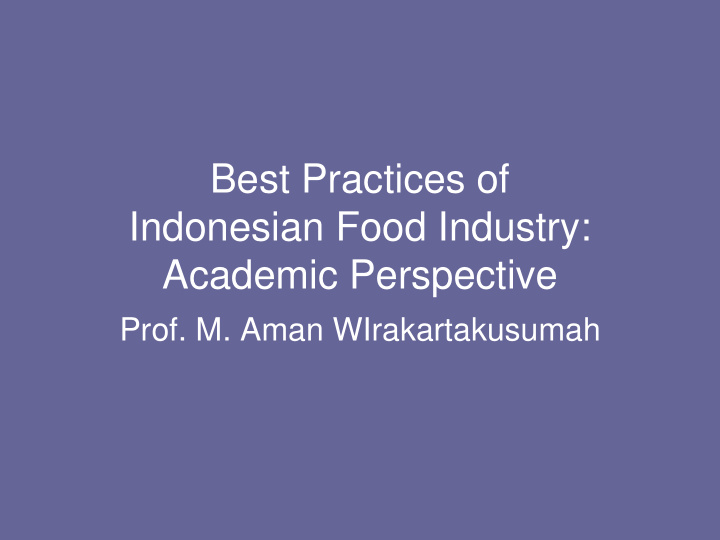



Best Practices of Indonesian Food Industry: Academic Perspective Prof. M. Aman WIrakartakusumah
Food Industries in Indonesia Large scale: 10.913 Size of I ndustry in I ndonesia* Medium scale : 70.225 Small scale : 640.000 16.9 millions are of micro-small scale 9 millions are food industries* Micro 16.3 million *54% is food industry (National Statistics Bureau)
Food Industries in Indonesia • Market: – Local/National – International: major driving force for food safety improvement
International Food Trade • Already 40% of all trade in agriculture, fisheries & forestry occurs between developing & developed countries. • More than 20% of all US imports are food products (more than 8 million shipments a year). Hariyadi, 2010
International Food Trade • International food trade is growing, as consumers take advantage of lower prices and greater seasonal availability of some foods abroad. • Agreement on the Application of Sanitary and Phytosanitary Measures • Sanitary measures � human and animal health • Phytosanitary measures � plant protection • While often legitimately employed to protect public health (SPS) • measures can potentially be seen as barriers to trade
International Food Trade Indonesian shrimp exports • The peak of the value of this sector was in 2001, which was the golden year of shrimp exports • Since September 2001, the EU has required virus-free and antibiotic-free shrimp imports, obliging all imported shrimp to be free of chloramphenicol. • The EU has refused entry of Indonesian shrimp and other seafood products based on health and sanitary reasons. • Contribute to the decrease of export value from Indonesia to EU by 2.6% in 2002 and 15.8% in 2003 Hariyadi, 2010
EU: Number of notification by RASFF Number of notification Histamine Vet drug Heavy metals Microbiology sensory total Lambaga, 2009
USA: Reasons for automatic detention of Indonesian seafood Others Lambaga, 2009
Asia: Recall of Indonesian Instant Noodle in Taiwan • Reason for recall: Paraben (Methyl P ‐ Hydroxybenzoate) in sweet soy sauce of the instant noodle • JECFA: Group ADI: 0 ‐ 1000 mg/kg body weight • NADFC Indonesia: maximum limit is 250 mg/kg of product • Taiwan: 0 mg/kg of product (does not allow)
Best Practices : MoniQA • MoniQA: Monitoring and Quality Assurance in the Food Supply Chain • Funded by EU • Members: all over the world • To help food manufacturers, retail outlets and regulatory bodies to cope with the challenges posed by a globalised food economy. • MoniQA is establishing common methods and standards in food analysis • Example: shelf life training for food industries and food authorities of member countries
Best Practices : The ASEAN Food Safety Standards Harmonization Working Group Example: status of Preservatives in National Food Safety Standards in ASEAN* GSFA FSANZ BR CB ID LA MM MY PH SG TH VN Benzoate SF SF SF SF SF SF SF SF SF Sorbates SF GMP SF SF SF SF SF SF SF Erythorbate SF GMP N Rev N GMP GMP SF SF Sulphite SF SF SF SF SF GMP SF SF SF Propionates SF SF SF SF SF SF SF SF SF SO2 SF SF SF SF SF SF SF SF SF Di-methyl dicarbonate SF SF SF Rev SF SF SF ? SF Nitrates SF SF SF SF SF SF SF SF SF Nitrites SF SF SF SF SF SF SF SF N Nisin SF SF SF Rev N SF SF SF SF Orthophosphoric acid SF SF SF Rev N SF GMP SF SF Calcium formate* SF GMP Rev N SF N N SF Lysozyme SF GMP Rev N SF SF SF SF * = Formic acid (GSFA) BR = Brunei MY = Malaysia SF = Permitted in specific food only CB = Cambodia PH = Philippines GMP = Good Manufacturing Practices ID = Indonesia SG = Singapore Rev = Being reviewed LA = Lao PDR TH = Thailand N = Not permitted MM = Myanmar VN = Vietnam ? = Need clarification GSFA (Codex Standards) FSANZ (Food Standards Australia New Zealand) *ASEAN Food Safety Harmonization Workshop, 2004
Best Practices: Compliance to international/importer standards – FDA regulations, e.g. 21 CFR 108, 113, 114 – Application of SPS measures – Application of ISO in seafood industries – Application of GMP, SSOP, and HACCP – Food ingredients limit
Best Practices: Capacity building Training for farmer, packaging producer, food processor, and regulator: – Thermal processing of Foods – Hazard Analysis Critical Control Point (HACCP) – Food Sanitation and Hygiene – Good Manufacturing Practices (GMP) – Food Packaging and Labeling – Shelf Life Evaluation of Food
Best Practices • Integrated sardine cannery with fish oil and feed industry • Linkages of seafood industry with local fisherman and research institutions • Linkage between Indonesian cannery and research center for thermal process validation • Joint research between food industry and university/research center
Challenges – Development of national and international food regulation which both effectively protect the consumer and promote the development of food industry – Harmonization of food regulations – Promote preventive actions early from the production site
Thank you
Recommend
More recommend